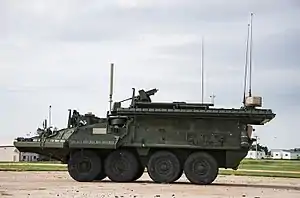Iron Curtain (countermeasure)
Iron Curtain is an active protection system (APS) designed by Artis, an American technology development and manufacturing firm. The system is designed to protect military vehicles and other assets by intercepting threats such as rocket-propelled grenades and other shoulder-launched missiles and rendering them inert.
| Iron Curtain | |
|---|---|
 Iron Curtain on a Stryker armored fighting vehicle | |
| Type | Active Protection System |
| Place of origin | United States |
| Production history | |
| Designer | Artis |
| Manufacturer | Artis |
| Specifications | |
The system was part of an accelerated acquisition effort by the U.S. Army to characterize and field active protection systems as quickly as possible.[1] It was evaluated on the Stryker Infantry Carrier Vehicle, with two systems undergoing tests by the U.S. Army: one at Aberdeen Proving Ground in Maryland and the other at Redstone Arsenal in Alabama.[2]
Technology
Iron Curtain uses a radar to detect the incoming round and cue the system. It then switches from armed-ready state to an armed state. As the round comes into close range, the optical sensor profiles the threat and tracks it within 1 cm (0.39 in) of accuracy to select an aimpoint and determine which ballistic countermeasure to fire. The countermeasure deflagrates the RPG warhead without detonating it, leaving the dudded round to bounce off the vehicles side.[3] Because of its shelf-like design, the system can be modified to protect almost any surface, from the sides of the vehicle to all around protection, including a turret. Artis claims that the Iron Curtain can be enhanced to protect against “more challenging threats” like the RPG-29 and RPG-32 ‘Hashim’ multipurpose anti-tank grenade launchers, which utilize tandem warheads for penetrating tanks with explosive reactive armor. Iron Curtain should also be able to defend against ATGMs (Anti-Tank Guided Missiles). The system has 360° coverage, is multi-shot, low-cost, low power, lightweight, and rugged and reliable.
Safety
The system, which began in 2005 as a DARPA program, is able to defeat threats even if fired from an extremely close range.[4] It has undergone significant safety testing, including temperature and shock testing, and its software architecture has been approved by the U.S. military's Joint Services Weapons Safety Review Process. The countermeasure fires straight down or up, neutralizing the incoming threat within inches of the vehicle and thereby separating the system from many others which intercept threats several meters out, resulting in minimal risk of collateral damage to dismounted troops or civilians.
Radar
Iron Curtain is designed to be highly modular, and the system's radar does not need to track the threat; hence, a relatively inexpensive radar will suffice. To date, two radars have been integrated onto Iron Curtain: the Mustang radar developed by Mustang Technology Group in Plano, Texas and the RPS-10 radar, built by RADA Electronic Industries.[5]
Government testing
In 2016, the U.S. Army began an expedited effort to install and characterize several APSs, including Iron Curtain on the Stryker fighting vehicle, in preparation for fielding decisions by the Army.[6][7]
In April 2013, the company announced it achieved a perfect score during rigorous government tests. “We proved not only that Iron Curtain defeats threats and saves lives, but the risk from collateral damage is minimal, especially when compared with the alternative," according to the company's CEO, Keith Brendley.[8] He said the system is ready to be deployed onto battlefields.[9]
Vehicles integrated
To date, the system has been integrated onto four ground vehicles, including tracked, turreted and wheeled vehicles. In 2016, Iron Curtain was selected for integration onto the U.S. Army's Stryker.[10] However, in August 2018 the Army decided not to continue qualifying Iron Curtain onto the Stryker, saying that while the system "generally worked in concept" and was "generally able to hit its targets," it was still not mature enough.[11]
Previously, Iron Curtain was integrated onto the Army's Ground Combat Vehicle built by BAE Systems; the MATV built by Oshkosh Defense; and the Humvee built by AM General.[12][13]
In addition, General Dynamics Land Systems designed the system for integration onto its LAV III.[14]
See also
References
- "Army to Equip brigade of Abrams with Active Protection Systems". National Defense Magazine. October 10, 2017. Retrieved 2017-10-16.
- "Iron Curtain ready to bring active protection to Stryker". Defense News. October 9, 2017. Retrieved 2017-10-16.
- "Artis Iron Curtain Active Protection System (APS): Shoot-Down Ballistic Reactive Ground Vehicle Defense System". DefenseReview.com (DR). 30 August 2009. Retrieved 2016-05-13.
- "Genius computer stops rockets right before impact". io9. June 25, 2011. Retrieved 2015-11-16.
- DoD Approves Israeli Radar for US Iron Curtain Testing - Defensenews.com, 30 August 2016
- 2017 Holds Key Army Decisions For Vehicle Active-Protection Kit, Defense News, December 16, 2016
- Army Vehicle-Mounted Developed Active Protection Systems Detect, Track and Destroy Enemy Fire - Scout.com/Military, 9 May 2016
- "Iron Curtain Successful in Firing Tests". Defense Update. April 29, 2013. Retrieved 2013-05-08.
- "Vehicle protection system excels". U.P.I. May 1, 2013. Retrieved 2013-05-08.
- 'Iron Curtain' ready to bring active protection to Stryker - Defensenews.com, 9 October 2017
- Iron Curtain is out as possible active protection system for Stryker. Defense News, 24 August 2018.
- "US Army; Two contenders gear up for GCV active protection". Defence Market Intelligence. June 24, 2013. Archived from the original on October 20, 2013. Retrieved 2015-01-29.
- "DARPA Iron Curtain Detects, Explodes RPGS from a moving Humvee". Gizmodo. December 2, 2009. Retrieved 2015-02-21.
- "Iron Curtain Active Protection System". Richard C. Young. May 30, 2013. Retrieved 2015-08-02.